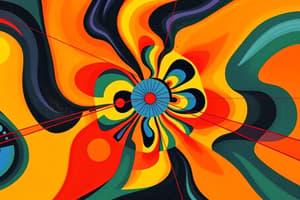Podcast
Questions and Answers
What is the term for the point of greatest distance a vibrating object moves from its equilibrium?
What is the term for the point of greatest distance a vibrating object moves from its equilibrium?
- Oscillation
- Vibration
- Resonant frequency
- Amplitude (correct)
What determines the resonant frequency of an object?
What determines the resonant frequency of an object?
- The material it is made of and its shape (correct)
- The initial vibration of the object
- The surrounding environment
- The size and color of the object
What happens when the frequency of an initial object's external vibration matches the resonant frequency of a second object?
What happens when the frequency of an initial object's external vibration matches the resonant frequency of a second object?
- The second object will change its resonant frequency
- The second object will stop vibrating
- The second object will vibrate or oscillate at a higher amplitude (correct)
- The second object will vibrate at a lower amplitude
What is an example of resonance in everyday life?
What is an example of resonance in everyday life?
Why does resonance not occur if the vibrating frequency does not match the resonant frequency of the item?
Why does resonance not occur if the vibrating frequency does not match the resonant frequency of the item?
What is a common characteristic of standing waves?
What is a common characteristic of standing waves?
What is the result of resonance in an RLC circuit?
What is the result of resonance in an RLC circuit?
What is the term for the disturbance that moves through a material from a given point to another point?
What is the term for the disturbance that moves through a material from a given point to another point?
What is the function of the body of a stringed instrument, such as a violin?
What is the function of the body of a stringed instrument, such as a violin?
What occurs when a light wave hits an object at a frequency that does not match the object's resonant frequency?
What occurs when a light wave hits an object at a frequency that does not match the object's resonant frequency?
What is required for resonance to occur in a musical instrument?
What is required for resonance to occur in a musical instrument?
What is a node in the context of a standing wave?
What is a node in the context of a standing wave?
What happens when the light wave frequency matches the resonant frequency of an object?
What happens when the light wave frequency matches the resonant frequency of an object?
What is the result of light transmission in an object?
What is the result of light transmission in an object?
What happens to the light wave that is reflected by an object?
What happens to the light wave that is reflected by an object?
What determines the color of an object that is visible to humans?
What determines the color of an object that is visible to humans?
Why can't we see the light that is absorbed by an object?
Why can't we see the light that is absorbed by an object?
What is the relationship between the resonant frequency of an object and the frequency of the absorbed light wave?
What is the relationship between the resonant frequency of an object and the frequency of the absorbed light wave?
What can be said about a blue ball?
What can be said about a blue ball?
What can be said about the properties of objects in relation to light?
What can be said about the properties of objects in relation to light?
Flashcards are hidden until you start studying
Study Notes
Resonance in Physics
- Resonance occurs when a vibrating object induces higher amplitude vibrations in a nearby object.
- Amplitude is the maximum distance a vibrating object moves from its equilibrium point.
- Each object has a natural frequency, known as its resonant frequency, determined by its size, shape, and material.
- Resonance happens when the frequency of an external vibration matches the resonant frequency of another object.
- A weak oscillation in one object can cause significant oscillation in another due to resonance.
- The term "resonance" derives from the Latin word "resonantia," meaning "echo."
Everyday Examples of Resonance
- Swings exhibit resonance when pushed at specific frequencies, resulting in higher swings.
- Rope bridges can vibrate strongly or collapse when groups cross in sync with the bridge's resonant frequency.
- Pendulum clocks utilize the resonant frequency of the pendulum’s swing.
Conditions for Resonance
- Resonance occurs when the vibrating frequency of one object closely matches the resonant frequency of another.
- If the frequencies do not match, resonance will not take place.
Wave Resonance
- A wave is a disturbance traveling through a medium (e.g., air, water).
- Standing waves, a form of resonance, occur when two waves of matching frequencies move in opposite directions and interfere.
- Nodes are fixed points in standing waves that do not move, while antinodes are points of maximum amplitude between nodes.
Examples of Standing Waves
- Standing waves are prominent in musical instruments; for example, when a guitar string is plucked, two waves traveling in opposite directions create nodes at the ends of the string.
Resonance in RLC Circuits
- RLC circuits consist of a resistor (R), inductor (L), and capacitor (C) connected in series.
- Resonance happens when the inductance and capacitance are equal, maximizing power transfer within the circuit.
Resonance in Musical Instruments
- Musical instruments amplify sound through vibrations that match their resonant frequency.
- In drums, striking the surface causes the entire instrument to vibrate, enhancing sound output.
- Brass instruments rely on the musician's lips to create vibrations that are amplified inside the instrument.
- Stringed instruments, like violins, use the body as a resonator, allowing sound waves to travel and resonate through the hollow body.
Resonance of Light Waves
- Light waves are electromagnetic waves that can cause objects to vibrate when they hit them.
- If the frequency of light does not match the object's resonant frequency, vibrations are weak and transient, leading to light reflection or transmission.
- When light matches an object's resonant frequency, it is absorbed, influencing the perceived color of the object; for instance, a blue ball absorbs all colors except blue, which it reflects.
Studying That Suits You
Use AI to generate personalized quizzes and flashcards to suit your learning preferences.




